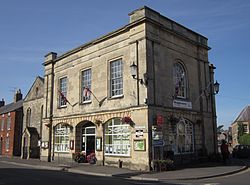Berkeley
| Berkeley | |
| Gloucestershire | |
|---|---|
 Town hall | |
| Location | |
| Grid reference: | ST684992 |
| Location: | 51°41’28"N, 2°27’32"W |
| Data | |
| Population: | 1,865 (2001) |
| Post town: | Berkeley |
| Postcode: | GL13 |
| Dialling code: | 01453 |
| Local Government | |
| Council: | Stroud |
| Parliamentary constituency: |
Stroud |
Berkeley is a town in Gloucestershire, in the Vale of Berkeley on the east bank of the River Severn (with the M5 motorway hemming it in). The town is noted for Berkeley Castle where the imprisoned King Edward II was murdered.
Berkeley is located mid-way between Bristol and Gloucester. It is built on a small hill in the Vale of Berkeley, with the Little Avon River flowing by, which river enters the Severn at Berkeley Pill. The Little Avon was tidal, and so navigable, for some distance inland (as far as Berkeley itself and the Sea Mills at Ham) until a 'tidal reservoir' was implemented at Berkeley Pill in the late 1960s.
History
Berkeley was first recorded in 824 as Berclea, from the Old English for “birch-tree wood or clearing”.[1]
Berkeley was a significant place in mediæval times. It was a port and market-town, and the meeting place of the Berkeley Hundred. The parish of Berkeley was the largest in Gloucestershire.[2] It is believed that the translator John Trevisa became vicar of Berkeley in 1374.[3]
Formerly the parish included the tithings of Alkington, Breadstone, Ham, Hamfellow and Hinton, and the chapelry of Stone, which became a separate parish in 1797. Hinton became a separate civil parish, and the separate ecclesiastical parish of Sharpness with Purton,[4] in the 20th century.
Berkeley was also the site of Berkeley nuclear power station, which has two Magnox nuclear reactors. This power station, the first commercial British reactor to enter operation, has since been decommissioned and all that remains are the two reactors encased in concrete. The administrative centre adjacent to the station is still active however - the centre was founded as Berkeley Nuclear Laboratories in the early 1960s and was one of the three principal research laboratories of the CEGB.
Transport
Just north of Berkeley lies the port of Sharpness, one of the most inland port in Britain. The Gloucester & Sharpness Canal (originally known as the Gloucester & Berkeley canal) starts here.
From 1876 to 1964 the town had a railway station, originally on a branch from a junction at Berkeley Road on the Bristol and Gloucester Railway. From 1879 the branch became a through-route to Lydney when the Severn Railway Bridge was opened. However, the bridge was damaged beyond repair by a ship collision in 1960.
Outside links
- The Edward Jenner Museum & Old Cyder House Conference Centre
- Berkeley Castle
- St. Mary's 13th Century Church, Berkeley
- BBC archive film of Berkeley from 1983
References
- ↑ Mills, A.D. and Room, A. A Dictionary of British Place-Names
- ↑ A Topograhical Dictionary of England (1848)
- ↑ Ronald Waldron, ‘Trevisa, John (b. c.1342, d. in or before 1402)’, Oxford Dictionary of National Biography, Oxford University Press, 2004
- ↑ St Mary's, Berkeley website